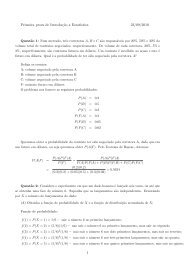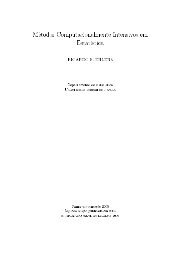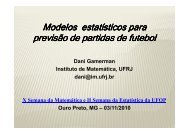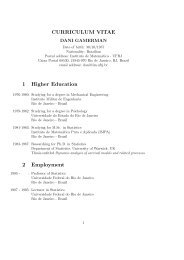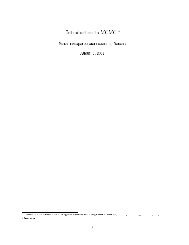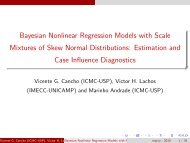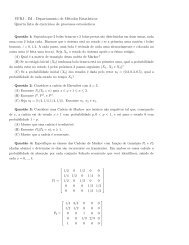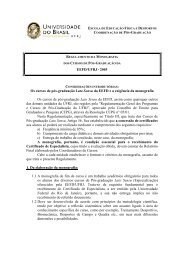Copulas: a Review and Recent Developments (2007)
Copulas: a Review and Recent Developments (2007)
Copulas: a Review and Recent Developments (2007)
Create successful ePaper yourself
Turn your PDF publications into a flip-book with our unique Google optimized e-Paper software.
Example (a pitfall of the conditional copula, Patton (2006)). Consider XjW 1 ,Y jW 2 <strong>and</strong> C W1 ;W 2(:j W 1 ;W 2 )<strong>and</strong>specifyH W1 ;W 2(x; yjW 1 ;W 2 )=C W1 ;W 2(F W1 (xjW 1 );G W2 (yjW 2 ) j W 1 ;W 2 ):Then, H W1 ;W 2(x; 1j W 1 ;W 2 )=F W1 (xjW 1 ) which is the conditional marginal distributionof (X; Y )jW 1 . By analogy, H W1 ;W 2(1;yjW 1 ;W 2 )=G W2 (yjW 2 ), the conditionaldistribution of (X; Y )jW 2 . Thus the function H W1 ;W 2can not be the joint distributionof (X; Y ) j W 1 ;W 2 in general. The only exception is the very special case whenF W1 (xjW 1 )=F W1 (xjW 1 ;W 2 )<strong>and</strong>G W2 (yjW 1 )=G W2 (yjW 1 ;W 2 ).The conditional bivariate copula de¯nitioncanbereformulatedintermsofsubalgebraA containing the past information on the process of interest as follows.De¯nition (conditional copula, Fermanian <strong>and</strong> Scaillet (2005)). For everysub-algebra A the conditional copula with respect to A, associated with a vectorX =(X 1 ;::: ;X n ) is a r<strong>and</strong>om function C(:jA) :[0; 1] n ! [0; 1] such thatH(xjA) =C(F X1 (x 1 jA);::: ;F Xn (x n jA) jA)almost surely for every x =(x 1 ;::: ;x n ) 2 [¡1; 1] n . Such a function is uniqueon the product of values taken by the conditional marginal cumulative distributionfunctions F Xi (:jA);i=1;::: ;n:Even if this de¯nition is useful it is di±cult to meet a real situation such that certainvariables a®ect the conditional distribution of one variable but not the other. Inpractice, the marginal distributions are usually de¯ned with respect to past marginalvalues. Consider for example the Markovian process S i;t ; i =1;::: ;n: One workseasily with conditional distribution of S i;t knowing S 0;t , than with the conditional distributionof S i;t knowing the full vector S 0 =(S 0;1 ;::: ;S 0;n ), related with past historyof the process. Actually, it is much simpler to model future returns of a stock index,say SI 1 , knowing the past history of this index (by some state-space or stochasticvolatility models) than knowing the past values of SI 1 <strong>and</strong> an additional one, SI 2say.The practitioners often prefer to implement their marginal models in informationsystems <strong>and</strong> the idea is to use them for analysis of more complex multivariate models.The necessity to de¯ne the notion of conditional pseudo-copula is motivated by thefact that marginal processes are usually better known than dependence structures. Inorder to formalize this mathematically, let us consider the sub-algebras A 1 ;::: ;A n ,B <strong>and</strong> denote A =(A 1 ;::: ;A n ). These sub-algebras can not be chosen arbitrarily,but assuming the following condition: Let x <strong>and</strong> y be n-dimensional vectors. Foralmost every w 2 − the relation P (X i · x i jA i )(w) =P (X i · y i jA i )(w) for everyi =1;::: ;n implies P (X · xjB)(w) =P (X · yjB)(w). For example, this conditionis satis¯ed when all conditional distributions of X 1 ;::: ;X n are strictly increasing, orwhen A 1 = ¢¢¢= A n = B, as in Patton (2006).14




